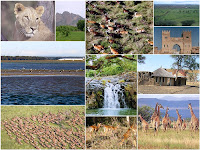Save Lake Victoria
Lake Victoria - the second largest fresh water lake in the world - is said to have experienced the greatest mass extinction of vertebrates in modern times. Thirty years ago the Lake boasted over 400 fish species. More than half are now extinct. The Nile Perch, most probably introduced in to the Lake deliberately in the 1950s - has been as disruptive to Lake Victoria's ecosystem as Man has been. The legendary river, the Nile, that flows from the Great Lake - is no better off: it's listed as one of the top ten World's rivers that are fast dying as a result of climate change, pollution and dams.'
Human activity has already excessively polluted the Lake but now Lake Victoria faces another great danger: water hyacinth has re-invaded the Lake choking thousands of hectares of the lake's surface - especially in Kenya. The species, which is originally from South America but today is a costly invasive species worldwide, first established itself in Lake Victoria, Africa's largest lake, in 1989. A few years ago, most scientists believed that the fight against the weed was getting on well and there was nothing much to fear or worry from it, but now it's feared that the weeds have re-invaded the Lake. And much more aggressively than before.
More than thirty million people in Kenya, Uganda, and Tanzania rely on the Lake for its natural resources. With its vast and abundant fresh water reservoir, Lake Victoria is undoubtedly one of the greatest treasures that East Africa has. Protecting and saving the Lake and all life forms that depend on it should be a priority. Already Man and the Nile Perch have caused enormous damage to the Lake; and now the weed, which reproduces and spreads rapidly - while choking most other life forms around, is rapidly spreading its tentacles. Although it would require huge amounts of time and money - the weeds must be stopped; and as indestructible as they are, they must be eradicated. The alternative to not doing that, would be too costly and destructive to all: Man and other life forms that depend on the Great Lake.
Human activity has already excessively polluted the Lake but now Lake Victoria faces another great danger: water hyacinth has re-invaded the Lake choking thousands of hectares of the lake's surface - especially in Kenya. The species, which is originally from South America but today is a costly invasive species worldwide, first established itself in Lake Victoria, Africa's largest lake, in 1989. A few years ago, most scientists believed that the fight against the weed was getting on well and there was nothing much to fear or worry from it, but now it's feared that the weeds have re-invaded the Lake. And much more aggressively than before.
More than thirty million people in Kenya, Uganda, and Tanzania rely on the Lake for its natural resources. With its vast and abundant fresh water reservoir, Lake Victoria is undoubtedly one of the greatest treasures that East Africa has. Protecting and saving the Lake and all life forms that depend on it should be a priority. Already Man and the Nile Perch have caused enormous damage to the Lake; and now the weed, which reproduces and spreads rapidly - while choking most other life forms around, is rapidly spreading its tentacles. Although it would require huge amounts of time and money - the weeds must be stopped; and as indestructible as they are, they must be eradicated. The alternative to not doing that, would be too costly and destructive to all: Man and other life forms that depend on the Great Lake.


